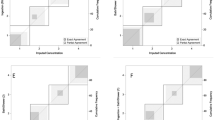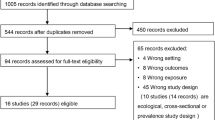Abstract
Trihalomethanes are common contaminants of chlorinated drinking water. Studies of their health effects have been hampered by exposure misclassification, due in part to limitations inherent in using utility sampling records. We used two exposure assessment methods, one based on utility-wide sampling averages, and one based on measurements from the utility sampling site closest to the subject's residence, to reestimate total trihalomethane (TTHM) exposure for 4212 participants in a preexisting study of risk factors for spontaneous abortion (SAB). For both approaches we performed unweighted, weighted, and subset analyses. The weighted and subset analyses were intended to reduce exposure misclassification, and were based on within-utility variance in TTHM measurements for the utility-wide average approach, and the distance between the subject's residence and sampling site for the closest-site approach. In general, the utility-wide average methods produced odds ratios equivalent to or slightly higher than the closest-site methods. Odds ratios obtained using the utility-wide average, but not the closest-site, approach also became progressively stronger in the weighted and subset analyses. A dose–response was seen between SAB and an exposure metric incorporating both TTHM concentration (utility-wide average approach) and personal ingestion, with SAB rates ranging from 8.3% to 13.7% (unweighted), 7.9% to 16.6% (variance weighted), and 6.6% to 23.1% (low-variance subset). Utility-wide average TTHM exposure assessment methods together with variance-based weights and subsets are relatively simple exposure assessment techniques, which may increase the epidemiologic usefulness of utility sampling records.
This is a preview of subscription content, access via your institution
Access options
Subscribe to this journal
Receive 6 print issues and online access
$259.00 per year
only $43.17 per issue
Buy this article
- Purchase on Springer Link
- Instant access to full article PDF
Prices may be subject to local taxes which are calculated during checkout
Similar content being viewed by others
References
Bellar, TA, and Lichenberg, JJ . Determining volatile organic compounds at microgram-per-liter levels by gas chromatography. J Am Water Works Assoc (1974) 66: 739–744
Deane, M, Swan, SH, Harris, JA, Epstein, DM, and Neutra, RR . Adverse pregnancy outcomes in relation to water contamination, Santa Clara County, California, 1980–1981. Am J Epidemiol (1989) 129: 894–904
Deane, M, Swan, SH, Harris, JA, Epstein, DM, and Neutra, RR . Adverse pregnancy outcomes in relation to water consumption: a re-analysis of data from the original Santa Clara County study, California, 1980–1981. Epidemiology (1992) 3: 94–97
Fleiss, JL . Statistical Methods for Rates and Proportions, 2nd ed. Wiley, New York, NY 1981 pp. 188–211
Jo, WK, Weisel, CP, and Lioy, PJ . Chloroform exposure and the health risk associated with multiple uses of chlorinated tap water. Risk Anal (1990) 10: 581–585
Lynberg, M, Nuckols, JR, Langlois, P, Ashley, D, Singer, P, Mendola, P, Wilkes, C, Krapfl, H, Miles, E, Speight, V, Lin, B, Small, L, Miles, A, Bonin, M, Zeitz, P, Tadkod, A, Henry, J, and Forrester, MB . Assessing exposure to disinfection by-products in women of reproductive age living in Corpus Christi, Texas, and Cobb County, Georgia: Descriptive results and methods. Environ Health Perspect (2001) 109: 597–604
Rook, JJ . Formation of haloforms during chlorination of natural waters. J Soc Water Treat Exam (1974) 23: 234–243
Singer, PC, and Chang, SD . Correlations between trihalomethanes and total organic halides formed during water treatment. J Am Water Works Assoc (1989) 81: 61–65
Singer, PC, Obolensky, A, and Greiner, A . DBPs in chlorinated North Carolina drinking waters. J Am Water Works Assoc (1995) 87: 83–92
Swan, SH, and Waller, K . Disinfection by-products and adverse pregnancy outcomes: What is the agent and how should it be measured? [Editorial] Epidemiology (1998) 9: 479–481
Swan, SH, Waller, K, Hopkins, B, Windham, G, Fenster, L, Schaefer, C, and Neutra, RR . A prospective study of spontaneous abortion: relation to the amount and source of drinking water consumed in early pregnancy. Epidemiology (1998) 9: 126–133
Symons, JM, Stevens, AA, Clark, RM, Geldreich, EE, Love, OT Jr., and DeMarco, J . Treatment techniques for controlling trihalomethanes in drinking water. U.S. EPA 600/2-81-156. U.S. Environmental Protection Agency, Washington 1982
U.S. Environmental Protection Agency. National interim primary drinking water regulations. Fed Reg (1975) 40: 14159566 (December 24, 1975)
Waller, K, Swan, SH, DeLorenze, G, and Hopkins, B . Trihalomethanes in drinking water and spontaneous abortion. Epidemiology (1998) 9: 134–140
Weisel, CP, Jo, WK, and Lioy, PJ . Utilization of breath analysis for exposure and dose estimates of chloroform. J Exposure Anal Environ Epidemiol (1992 Suppl 1 55–69
Windham, GC, Swan, SH, Fenster, L, and Neutra, RR . Tap or bottled water consumption and spontaneous abortion: a 1986 case–control study in California. Epidemiology (1992) 3: 113–119
Wrensch, M, Swan, SH, Lipscomb, J, Epstein, DM, Neutra, RR, and Fenster, RR . Spontaneous abortions and birth defects related to tap and bottled water use, San Jose, California, 1980–1985. Epidemiology (1992) 3: 98–103
Acknowledgements
We acknowledge the invaluable assistance of Rebecca Calderon and Pauline Mendola of the U.S. Environmental Protection Agency (EPA) and the staff of the participating drinking water utilities. Barbara Hopkins of the California Department of Health Services and Cathy Schaefer, Robert Hiatt, and Soora Wi of the Kaiser Permanente Division of Research were instrumental in designing and conducting the Pregnancy Outcome Study.
The research described in this article has been supported by the U.S. EPA through grant 8D-1263-NANX and cooperative agreement CR 827270-01-0. It has been subjected to Agency review but does not necessarily reflect the views of the Agency and no official endorsement should be inferred. The Pregnancy Outcome Study was supported by the State of California and the Packard Foundation.
Author information
Authors and Affiliations
Corresponding author
Rights and permissions
About this article
Cite this article
WALLER, K., SWAN, S., WINDHAM, G. et al. Influence of exposure assessment methods on risk estimates in an epidemiologic study of total trihalomethane exposure and spontaneous abortion. J Expo Sci Environ Epidemiol 11, 522–531 (2001). https://doi.org/10.1038/sj.jea.7500191
Received:
Published:
Issue Date:
DOI: https://doi.org/10.1038/sj.jea.7500191
Keywords
This article is cited by
-
Comparison of Trihalomethane exposure assessment metrics in epidemiologic analyses of reproductive and developmental outcomes
Journal of Exposure Science & Environmental Epidemiology (2023)
-
Toxicity-oriented water quality engineering
Frontiers of Environmental Science & Engineering (2020)
-
Development of an Analytical Procedure for the Determination of Trihalomethanes in Leafy Vegetable by Headspace-SPME Followed by GC-ECD Determination
Food Analytical Methods (2015)
-
Evaluation of two methods of interpolating quarterly trihalomethane levels between sampling dates
Journal of Exposure Science & Environmental Epidemiology (2009)
-
Variability and predictors of changes in water use during pregnancy
Journal of Exposure Science & Environmental Epidemiology (2009)



